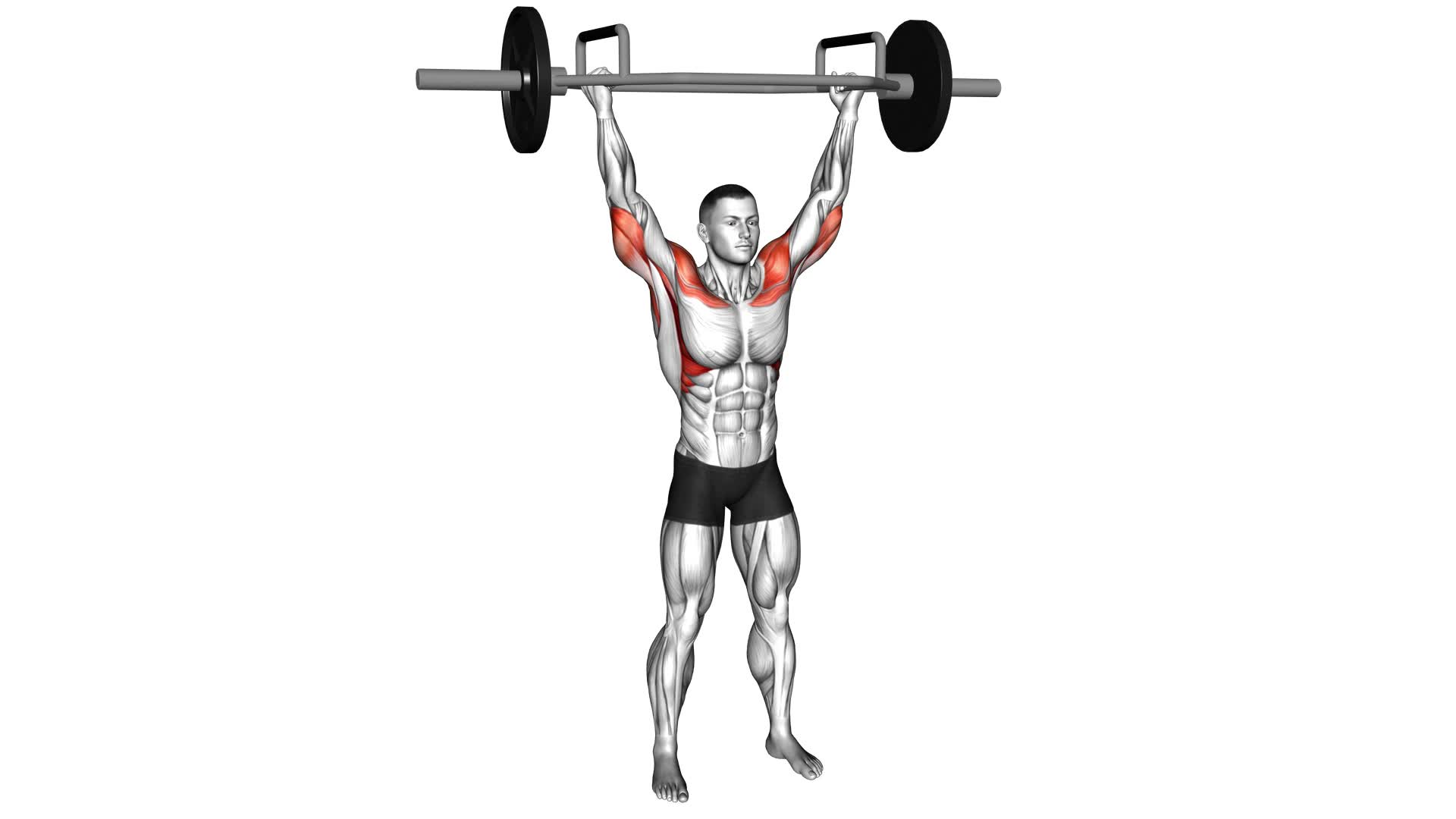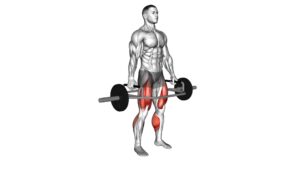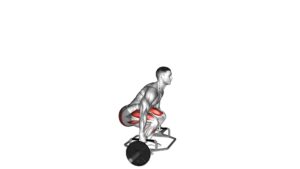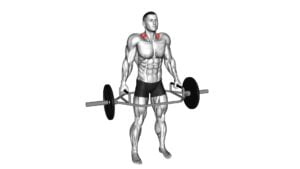Trap Bar Overhead Press (male) – Video Exercise Guide & Tips

Looking to build upper body strength? Check out this video exercise guide on the trap bar overhead press.
Watch This Exercise Video
In this tutorial, you'll learn the proper form and technique for this effective exercise. Discover how to choose the right weight for your fitness level and avoid common mistakes.
Plus, we'll share tips for increasing strength and progression. Whether you're a beginner or advanced, this guide will help you master the trap bar overhead press and achieve your fitness goals.
Key Takeaways
- The trap bar overhead press strengthens upper body muscles and engages multiple muscle groups.
- It improves overall fitness and functionality by activating shoulder muscles, core muscles, and promoting core stability.
- Proper form and technique are crucial to prevent strain on the lower back and ensure proper load distribution.
- Choosing the right weight and gradually increasing it as strength improves is important for progression and avoiding injury.
Benefits of the Trap Bar Overhead Press
You can experience numerous benefits by incorporating the Trap Bar Overhead Press into your workout routine. This exercise not only strengthens your upper body, but also engages multiple muscle groups, leading to improved overall fitness and functionality.
One of the main benefits of overhead pressing is the activation of your shoulder muscles, including the deltoids and trapezius. These muscles are responsible for stabilizing and controlling the movement of your arms during the exercise.
Additionally, the Trap Bar Overhead Press engages your core muscles, including the abs and lower back, as they work to stabilize your body and maintain proper form. This not only improves your strength and stability, but also helps to develop a strong and defined midsection.
Moreover, the Trap Bar Overhead Press also activates your triceps and upper chest muscles, contributing to balanced upper body development.
By incorporating this exercise into your routine, you won't only build strength and muscle, but also improve your overall functional fitness and enhance your athletic performance.
Now, let's move on to discussing the proper form and technique for the exercise.
Proper Form and Technique for the Exercise
To perform the Trap Bar Overhead Press exercise with proper form and technique, begin by standing in front of the trap bar. Position your feet shoulder-width apart and align them with the handles of the trap bar. Bend your knees slightly and hinge at the hips to grip the handles with an overhand grip. Keep your back straight and engage your core.
Before initiating the movement, ensure that your shoulder mobility is adequate. Lift the trap bar slightly off the ground, bringing it to shoulder height. Your palms should be facing forward, and your elbows should be bent at a 90-degree angle. This is your starting position.
To execute the exercise, press the trap bar overhead by extending your arms fully. Maintain control throughout the movement and avoid arching your back or locking out your elbows. Keep your core engaged to stabilize your body.
Lower the trap bar back to the starting position, maintaining a controlled descent. Repeat for the desired number of repetitions.
Remember to focus on proper form and technique throughout the exercise. By engaging your core and ensuring good shoulder mobility, you can perform the Trap Bar Overhead Press effectively and safely.
How to Choose the Right Weight for Your Fitness Level
When selecting the appropriate weight for the Trap Bar Overhead Press based on your fitness level, consider your strength and ability to maintain proper form and technique. Choosing the right weight is crucial to ensure that you effectively target the muscles and avoid injury. The weight should be challenging enough to provide resistance but not too heavy that it compromises your form.
To determine the appropriate weight, start with a weight that you can comfortably lift for 8-12 repetitions with proper form. This weight should feel challenging but manageable. If you can easily complete the set without feeling fatigued, it's a sign that the weight is too light. On the other hand, if you struggle to complete the repetitions or your form starts to break down, the weight is too heavy.
It's important to remember that your fitness level may change over time, so be open to modifying the weight as needed. As you progress and become stronger, you can gradually increase the weight to continue challenging yourself. Similarly, if you're just starting out or returning from a break, you may need to start with lighter weights and gradually work your way up.
Choosing the appropriate weight for the Trap Bar Overhead Press is essential for maximizing your results and minimizing the risk of injury. By considering your strength and ability to maintain proper form, you can ensure that you're challenging yourself appropriately and making progress towards your fitness goals.
Common Mistakes to Avoid During the Trap Bar Overhead Press
When performing the Trap Bar Overhead Press, it's important to pay attention to proper grip positioning. Make sure your hands are evenly spaced on the handles to maintain stability and prevent any imbalances.
Additionally, remember to engage your core throughout the exercise to maintain stability and prevent excessive arching of the back, which can lead to strain or injury.
Proper Grip Positioning
During the Trap Bar Overhead Press, it's important for you to maintain proper grip positioning to avoid common mistakes.
Proper hand placement is crucial for maximizing shoulder stability and ensuring a safe and effective exercise. To achieve the correct grip, position your hands slightly wider than shoulder-width apart on the trap bar handles.
Your palms should be facing forward, with fingers wrapped securely around the handles. Avoid gripping the bar too tightly, as this can lead to unnecessary strain on the wrists and forearms.
Additionally, make sure to keep your wrists in a neutral position throughout the movement to further enhance stability.
Core Stability Importance
To maximize your performance and reduce the risk of injury during the Trap Bar Overhead Press, it's crucial to prioritize core stability. Core stability refers to the ability of your core muscles to maintain proper alignment and support during movement.
Here are some reasons why core stability is important for the Trap Bar Overhead Press:
- Improved balance and stability: A strong and stable core allows you to maintain balance and control while pressing the weight overhead.
- Increased power transfer: Core stability helps to transfer force from your lower body to your upper body, allowing you to generate more power during the lift.
- Injury prevention: A weak core can lead to poor posture and compensatory movements, increasing the risk of injury to your back, shoulders, and hips.
- Enhanced overall performance: By strengthening your core, you improve your overall strength and stability, which can positively impact your performance in other exercises and activities.
To improve your core stability, incorporate exercises such as planks, Russian twists, and dead bugs into your training routine. Prioritizing core strength won't only improve your Trap Bar Overhead Press but also enhance your overall fitness and well-being.
Avoiding Excessive Arching
Maintaining proper alignment and avoiding excessive arching is crucial for a successful Trap Bar Overhead Press. Excessive arching can put strain on your lower back and compromise your form, leading to potential injuries.
To prevent excessive arching, focus on maintaining proper posture throughout the exercise. Start by standing with your feet shoulder-width apart and engage your core muscles to stabilize your spine. Avoid leaning back or hyperextending your lower back as you press the bar overhead. Instead, keep your spine neutral and your shoulders stacked directly over your hips.
By maintaining proper posture, you'll ensure that the load is properly distributed and avoid unnecessary strain on your lower back.
Now, let's move on to some tips for increasing strength and progression in the Trap Bar Overhead Press.
Tips for Increasing Strength and Progression
Focus on incorporating progressive overload techniques to maximize your strength gains and advance your progression with the Trap Bar Overhead Press. Here are four tips for increasing strength and progression:
- Gradually increase the weight: Start with a weight that challenges you but allows you to maintain proper form. As you get stronger, gradually increase the weight to continue challenging your muscles and stimulating growth.
- Vary your rep ranges: Incorporate both high and low rep ranges into your training. Higher reps help improve endurance and muscle definition, while lower reps focus on building strength and power. Alternating between the two can prevent plateaus and keep your progress moving forward.
- Utilize progressive resistance: Instead of sticking to the same weight and reps, aim to increase either the weight or the number of reps each week. This gradual increase in resistance forces your muscles to adapt and grow stronger over time.
- Take adequate rest days: Rest and recovery are essential for muscle growth and strength gains. Make sure to schedule in rest days between your Trap Bar Overhead Press sessions to allow your muscles time to repair and rebuild.
Variation and Modification Options for the Exercise
To make the Trap Bar Overhead Press more beginner-friendly, you can adjust your technique by using a lighter weight, focusing on proper form, and gradually increasing the intensity as you gain strength and confidence.
If you don't have access to a trap bar, you can try alternative equipment like dumbbells or resistance bands to mimic the overhead pressing motion.
These modifications allow you to tailor the exercise to your fitness level and available equipment, ensuring a safe and effective workout.
Technique Adjustments for Beginners
To improve your form as a beginner, start by using a lighter weight during the Trap Bar Overhead Press exercise. This will allow you to focus on mastering the correct technique before progressing to heavier weights.
Here are some technique modifications and beginner adjustments you can make to enhance your performance:
- Feet positioning: Place your feet shoulder-width apart and keep them firmly planted on the ground throughout the exercise. This will provide a stable base of support.
- Grip: Hold the trap bar with an overhand grip, keeping your hands slightly wider than shoulder-width apart. This grip will help maintain control and stability.
- Core engagement: Prioritize engaging your core muscles by bracing your abs and keeping your back straight throughout the exercise. This will help protect your spine and improve overall stability.
- Controlled movement: Slowly lower the trap bar to chin level, then press it back up overhead in a controlled manner. Avoid using momentum to lift the weight.
Equipment Alternatives for Home
For an effective at-home workout, you can modify the Trap Bar Overhead Press exercise by utilizing alternative equipment options.
If you don't have access to a trap bar, you can use dumbbells or kettlebells instead. These alternatives will still allow you to work your shoulders, triceps, and upper body effectively.
When using dumbbells, hold one in each hand and press them overhead simultaneously. If you opt for kettlebells, hold them by the handles with your palms facing inward and press them overhead.
Remember to maintain proper form and control throughout the exercise.
Frequently Asked Questions
Is the Trap Bar Overhead Press Suitable for Beginners?
Yes, the trap bar overhead press is suitable for beginners. It provides a great way to build upper body strength and engage multiple muscle groups.
To progress with this exercise, you can start with lighter weights and gradually increase the load as you become more comfortable and confident.
It's important to avoid common mistakes like arching your back or using momentum to lift the weight.
Focus on maintaining proper form and control throughout the movement.
Can the Trap Bar Overhead Press Help Improve Shoulder Stability?
Improving shoulder stability is crucial for overall upper body strength. Proper form during the trap bar overhead press is essential to prevent injuries and maximize results.
By engaging the shoulders and core, this exercise targets and strengthens the stabilizer muscles.
Advanced lifters can further challenge themselves by incorporating variations such as single-arm presses or adding resistance bands.
Remember to always consult a professional trainer to ensure you're performing the exercise correctly and safely.
What Muscles Does the Trap Bar Overhead Press Primarily Target?
The trap bar overhead press primarily targets your shoulders, specifically the deltoids (shoulder muscles). This exercise also engages your trapezius muscles, which are located in your upper back.
Incorporating trap bar overhead press variations in your workout routine can be beneficial for improving shoulder strength, stability, and overall upper body power. It's a great exercise to add to your routine if you're looking to develop strong and well-defined shoulders.
Is It Necessary to Warm up Before Performing the Trap Bar Overhead Press?
Before performing the trap bar overhead press, it's important to warm up to prepare your muscles and joints for the exercise. This helps prevent injuries and allows for better performance.
Warming up increases blood flow to the muscles and improves flexibility. It also helps activate the core and stabilizing muscles. So, take a few minutes to do some dynamic stretches and light cardio before getting into the trap bar overhead press.
Are There Any Specific Breathing Techniques That Should Be Used During the Trap Bar Overhead Press?
When performing the trap bar overhead press, it's important to pay attention to your breathing techniques and maintain proper form.
Breathing properly can help stabilize your core and maximize your strength and stability during the exercise. Take a deep breath before lifting the bar and exhale as you push it overhead. This will help engage your core and maintain stability throughout the movement.
Remember to maintain proper form and breathe consistently to get the most out of the trap bar overhead press.
Conclusion
In conclusion, the trap bar overhead press is a highly effective exercise for building upper body strength and stability.
By maintaining proper form and technique, choosing the appropriate weight, and avoiding common mistakes, you can maximize the benefits of this exercise.
Additionally, incorporating variations and modifications can help to challenge your muscles and promote progression.
By following these tips, you can enhance your strength and achieve your fitness goals.

Author
Years ago, the spark of my life’s passion ignited in my mind the moment I stepped into the local gym for the first time. The inaugural bead of perspiration, the initial endeavor, the very first surge of endorphins, and a sense of pride that washed over me post-workout marked the beginning of my deep-seated interest in strength sports, fitness, and sports nutrition. This very curiosity blossomed rapidly into a profound fascination, propelling me to earn a Master’s degree in Physical Education from the Academy of Physical Education in Krakow, followed by a Sports Manager diploma from the Jagiellonian University. My journey of growth led me to gain more specialized qualifications, such as being a certified personal trainer with a focus on sports dietetics, a lifeguard, and an instructor for wellness and corrective gymnastics. Theoretical knowledge paired seamlessly with practical experience, reinforcing my belief that the transformation of individuals under my guidance was also a reflection of my personal growth. This belief holds true even today. Each day, I strive to push the boundaries and explore new realms. These realms gently elevate me to greater heights. The unique combination of passion for my field and the continuous quest for growth fuels my drive to break new ground.







